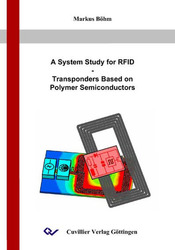| Departments | |
|---|---|
| Book Series (96) |
1378
|
| Nachhaltigkeit |
3
|
| Gesundheitswesen |
1
|
| Humanities |
2363
|
| Natural Sciences |
5406
|
| Engineering |
1791
|
| Engineering | 292 |
| Mechanical and process engineering | 861 |
| Electrical engineering | 686 |
| Mining and metallurgy | 30 |
| Architecture and civil engineering | 75 |
| Common |
98
|
|
Leitlinien Unfallchirurgie
5. Auflage bestellen |
|
Advanced Search
A System Study for RFID (English shop)
Transponders Based on Polymer Semiconductors
Markus Böhm (Author)Preview
Table of Contents, Datei (32 KB)
Extract, Datei (110 KB)
RFID transponders that are based on polymer integrated circuits have the potential to be produce d at high volume and low cost, due to the usage of soluble polymer semiconducting materials in printing processes. In this work, the concept of designing and simulating a passive polymer RFID transponder is presented. Models of the component soft he overall RFID-system, consisting of the reader and the polymer transponder, are derived. Simulation and measurement match well and show that inductive coupled polymer transponders can be operated at the standardized frequency of 13.56 MHz with a read range of at east 5cm. The read range is basically limited by the antenna design and the polymer rectifier. With the realized system simulation, the information transmission from the transponder to the reader can be simulated for various antenna designs, coding schemes and perturbations due to motion of the transponder.
| ISBN-13 (Printausgabe) | 3867273103 |
| ISBN-13 (Hard Copy) | 9783867273107 |
| ISBN-13 (eBook) | 9783736923102 |
| Final Book Format | A5 |
| Language | English |
| Page Number | 170 |
| Edition | 1 |
| Volume | 0 |
| Publication Place | Göttingen |
| Place of Dissertation | Erlangen |
| Publication Date | 2007-08-10 |
| General Categorization | Dissertation |
| Departments |
Electrical engineering
|
| Keywords | RFID, Organic, Polymer, Transponder system, Simulation |








